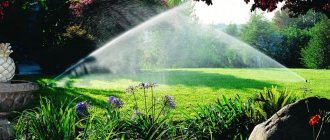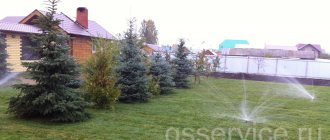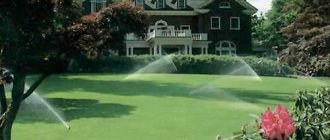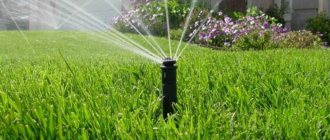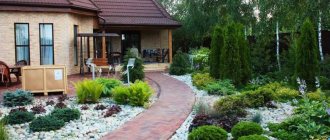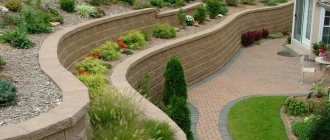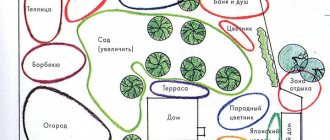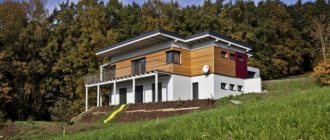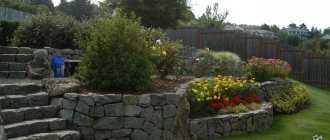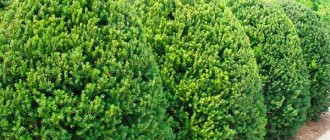Construction principles
The concept of automatic watering is briefly as follows. There is a water source, from which a main pipeline is routed across the site to the irrigation zones. Next, using tees, crosses, small-diameter pipes and water supply devices, an irrigation system is created. For normal operation of water outlet units, filters are required; they are installed on the main water supply. That's all. Everything else is specific. There may even be a pump or a control system, or you can do without them
Do-it-yourself automatic watering system is a real task
Read here how to organize water supply to your home from a well or borehole.
How to control
Irrigation can be controlled by a controller (automation unit) or a person by turning the tap. If a controller is installed, the system is almost completely automated: it turns the water supply on and off at a given time. There are devices with a very high degree of automation - they monitor the weather, soil moisture and adjust the operation of the equipment in accordance with this data. In the simplest version, automatic irrigation supplies water at a specified time and turns it off after a certain period of time (set in the settings).
If there is no irrigation controller, a person needs to open the water supply and stop it. But that’s all that’s required of you; the irrigation system will do the rest.
Water consumption and irrigation intensity
Since the flow of water through distribution points is generally normalized, it is possible to determine with fairly high accuracy how long watering should last so that there is not too much water and not too little. If all watered plants require the same amount of water, no difficulties arise, but this does not always happen. This is the case with a lawn; sometimes there are extensive plantings of identical plantings in a vegetable garden or garden. But a more common situation occurs when some plants are more moisture-loving, others less so. There are several ways to solve this problem:
- Install drippers or sprinklers with adjustable water flow. With their help, for each area or plant, set the required amount of moisture in one watering.
- Use multi-zone controllers. They can independently control multiple watering zones. This is convenient in the garden, garden or greenhouse, where there are extensive plantings of plants that require different moisture levels.
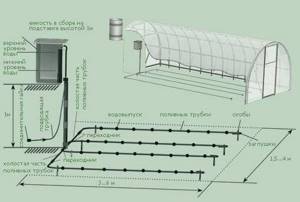
Sometimes it is more profitable to make two autonomous irrigation systems
- Make several independent systems. Sometimes this is more profitable than stretching a long pipeline from one section to another or purchasing complex controls.
That’s why you can do automatic watering yourself: you have a lot of opportunities to achieve the desired result.
Where to get water from
The source of water for an automatic irrigation system can be a water supply system, a container with pumped water, a well, a well, a river, or a lake. In all cases, filters are installed on the main pipeline. It's just that different sources require different equipment. If you pump water from an open source (river, lake), be sure to install a coarse filter first, then a fine filter. In all others (except for drinking water supply) only equipment for fine cleaning is installed.
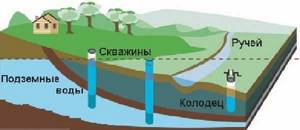
Watering the area with your own hands can be done from any water source.
If we are talking about automatic watering of a garden or greenhouse, then it is definitely better to first pump the water into a container where it will heat up, and then distribute it throughout the area. For dachas and garden plots there are a number of systems that work almost by gravity. They need minimal pressure, which is created by raising the container to a height of about 1-2 meters. There are systems that can work if the container is raised 10-40 cm above the ground (these are drip irrigation systems AquaDusya, Vodomerka and others, you can read about them here).
With such an organization - with a water container - you can choose any pump for an automatic irrigation system. If only he could periodically pump water into the tank. The water level in the container is most often controlled by a float mechanism (like the one in a toilet tank). In this case, do not forget to provide for an emergency overflow and take it to some source, otherwise your area may turn into a swamp.
If a water supply is used as a source - centralized or not, and drip irrigation is selected, a reducer is needed to reduce and stabilize the pressure in the system, since most of this equipment can operate at a pressure of no higher than 2 atm.
Accessories for automatic watering systems
When choosing equipment for an automatic irrigation system, you need to study its design and specifics of operation. Classic underground drip irrigation requires the installation of a pumping station, an automatic liquid supply sensor, filter elements, pipes and other components.
Selecting a pumping unit for automatic watering
If water is supplied to the site not from a centralized water supply system, but from a well, borehole or some kind of container, you will need to purchase a pump for automatic watering that can pump it. The device must provide the required pressure in the pipeline acting on the sprinkler nozzles.
When choosing pumping equipment, you need to be guided by the following criteria:
- Power indicators. The optimal value is selected taking into account the area of the site.
- Liquid consumption that will be needed for processing and irrigating garden crops.
- Automation support.
- Resistance to mechanical stress, aggressive compounds in the form of mineral fertilizers and other negative factors.
- Noise and vibration intensity.
- Soft start support.
- Specifics of installation and disassembly in case of breakdown.
To arrange rain irrigation, it is better to use a centrifugal pump. This unit is inexpensive and does its job well. You can consider a more expensive solution in the form of a vane device with a vertical or horizontal pump placement.
For large areas, axial pumping stations and vortex models have been developed.
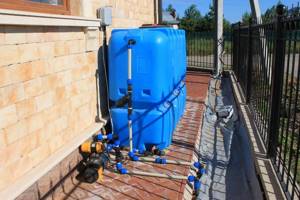
Controller and timer for automatic watering system for garden
A useful accessory that is equipped with automatic watering equipment is a timer, which ensures automatic operation of the system based on time. Depending on the control method, the following types of devices are distinguished:
- Automatic models. They support a number of operating modes and can perform watering according to a given program. The advantage of this variety is optimal water consumption and efficient irrigation of the site.
- Manual or mechanical models. They ceased to be in demand when automatic devices appeared on the market.
In addition, timers differ in terms of use:
- For garden crops. In gardens, you can install mechanical, electronic and automatic devices that are connected to a centralized water supply or a water tank.
- For garden plantings. This group includes water controllers or electronic timers that set the optimal operating mode, taking into account the characteristics of the bed.
- For greenhouses. In such conditions, drip equipment with an automatic controller is used.
Pipes, filters and other equipment
To organize automatic watering of a lawn or garden bed, you will need to select components. First of all, you should purchase a high-quality pipeline that will connect the irrigation system to the water supply source. Elements are placed at each site and connected through valves and sprinklers.
The pipeline can be metal or plastic. Most owners of summer cottages install irrigation from polypropylene pipes, claiming that they can easily withstand temperature changes and have a long service life.
Polypropylene pipes have a smooth inner surface that is not capable of accumulating debris and other deposits. Polypropylene is not afraid of contact with aggressive environments and ultraviolet rays, and is suitable for installation both underground and on the surface.
The connection of individual elements is carried out by soldering or fittings.
Source of water supply
There are a number of water supply sources that can be used to irrigate household plots. When choosing the best option, you need to take into account a number of nuances. If there is a central system in the area near the house, it would be reasonable to connect equipment from the automatic watering system to it. The advantage of this connection method is the absence of restrictions in processing the area, but there are also disadvantages:
- If the pressure in the pipes drops, the plants will not be able to receive the required amount of moisture.
- Due to frequent interruptions in the system, irrigation will be carried out randomly and not according to the planned schedule.
When faced with one of these problems, you need to consider organizing a different system.
For example, you can connect the equipment to an artesian well - in this case, you can use both drip and jet types of irrigation. However, the process of drilling a well is labor-intensive and expensive, and there is a possibility that experts will not allow using a natural source of water for automatic irrigation with your own hands. This is explained by the insufficient static or dynamic level of liquid in it.
If it is not possible to use the two previous options, you can consider the option of arranging a storage tank. In most cases, it consists of a plastic tank that is installed at a level of 1 m above the ground, which provides a stable pressure of 0.1 atmospheres.
The advantage of storage tanks is that the water warms up under the influence of solar heat, making it comfortable for treating green spaces.
If you use a pump unit, you can achieve any pressure indicators.
Automatic watering schemes
There are many options and variations of schemes. They are very mobile and allow you to take into account all the features of areas and plantings. Let's consider the case when water is supplied from a source using a pumping station directly for watering plants. This option for automatic watering is shown in the photo below.
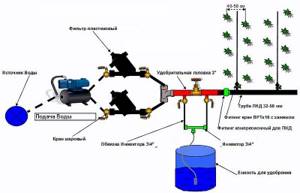
Such a do-it-yourself irrigation system at the dacha can be assembled in a day
Water can be supplied to the plants in drops or using sprinklers. There is a fertilizer application unit. It will be useful in an automatic watering system for a vegetable garden, greenhouse or garden, although it will also not be superfluous for a lawn and garden. The number of irrigation lines is determined depending on the need, then the pressure is calculated. Drippers or sprinklers are selected according to the amount of water needed by the plants.
The diagram of an automatic irrigation system using sprinklers is shown in the photo below. These devices have several names: sprinklers and sprinklers, which is why watering is called “sprinkler”.
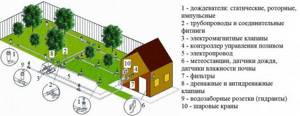
The sprinkler irrigation system is suitable for watering lawns or small plantings - up to 10-15 cm
The main difference between lawn watering systems is that the pipelines are often laid underground. To prevent sprinklers from interfering with lawn mowing, they should also be hidden in the ground. There are also such models.
The diagram for automatic watering of a vegetable garden, greenhouse and orchard is shown in the figure below. Water is first pumped into the container. From there it can be supplied by gravity if the water supply is drip (which is what is shown). To provide the required pressure for the sprinklers, you will need to install a pump or pumping station.
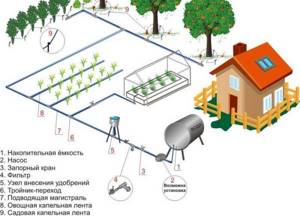
Irrigation system at the dacha from a container
If your garden, orchard or greenhouse needs moisture, you can arrange everything as in the figure below. It differs from the fact that at the top it has a pumping station that supplies water to the filters, after which the pipeline already diverges to the beds.
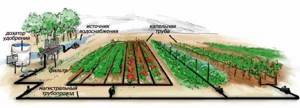
Do-it-yourself automatic watering of the garden can be assembled from components or you can buy ready-made watering kits
Procedure for developing a do-it-yourself irrigation system
First, take a scale plan of the site. If you don’t have it ready, draw it on graph paper or a large checkered piece of paper. Apply all buildings, beds, large plants.
Configuration development
On the plan, draw the irrigation zones, the water source, and its location. At the same time, draw where the main pipeline will pass. If you are going to spray with sprinklers, draw areas of their effect. They should overlap and there should be no unwatered areas.
If the plantings are planted in rows, it is more rational to use drip irrigation: water consumption is much less, as is the cost of equipment. When designing a drip irrigation scheme, the number of irrigation lines depends on the distance between the rows. For rows with a distance of more than 40 cm, one line per row is required. If the rows are located closer than 40 cm, I water between the rows and there are one fewer lines.
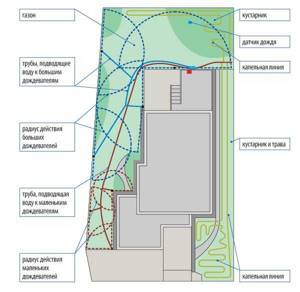
DIY irrigation system development
After all the sections have been drawn, decide on the length of the required pipelines, count how many and what water distribution points you have, decide on the equipment - the number of pipes, hoses, tees, drippers, sprinklers, whether or not you need a pump and reducer, it will be whether the container is installed or not, what automation should be installed and where. Now, after all this has already been thought out, right down to the diameters of pipes, fittings and adapters, the practical stage begins. The irrigation system drawn on paper begins to be implemented on your site.
Let's start building
Construction work is already underway. And the first thing you need is to decide how you will lay the pipes. There are two ways: lay the pipeline on top or bury it in a trench. They usually lay it on the ground at the dacha: here the watering is seasonal and it is dismantled in the fall. It is very rare that irrigation systems in dachas are left for the winter: even if the equipment can withstand the winter, it can simply be broken or stolen.
When creating an automatic watering system for the site of a permanent residence, they try to make everything as inconspicuous as possible, so the pipes are buried. In this case, trenches are dug with a depth of at least 30 cm. This depth is sufficient so that the pipes are not damaged during excavation work. Just remember that pipes, fittings and other equipment that is left over the winter must be able to withstand freezing.
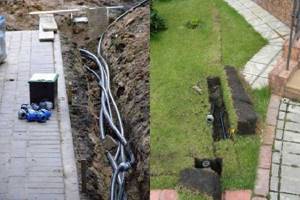
One of the stages of creating automatic irrigation with your own hands is earthworks and laying main hoses
Branches for irrigation depart from the main water pipelines. It is advisable to make all assemblies and connections in hatches with covers: namely, in connections, tees, etc. Most often leaks occur. Digging out an entire trench to find a leak is not the most fun, and if all the “problem spots” are known in advance and relatively accessible, maintenance becomes an easy task.
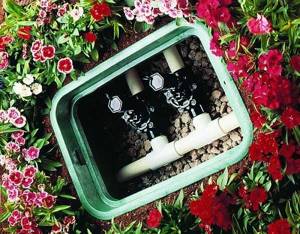
When laying main pipelines underground, install connection points in special boxes
The last stage - depending on the chosen irrigation method, water distribution devices are installed in the hoses, everything is connected and tested.
Drip irrigation as a type of automatic watering system at the dacha
Drip watering for gardening and vegetable gardens is the most popular type of irrigation today. It is advisable to arrange it in small areas with parallel planting of plants. This is the most economical irrigation option, since water is supplied to garden crops by drip. It is advisable to arrange such automatic watering at low pressure in the irrigation system.
A storage tank with water located at a certain height is used as a source of water supply. A main pipeline is connected to the tank, which carries water to distribution hoses laid parallel to each other. Do-it-yourself automatic drip irrigation is used for berries and garden crops, shrubs, trees and flowers. Such a system is often equipped in small greenhouses, flower beds and vegetable gardens.
Today it is possible to buy a ready-made kit, which necessarily includes a timer, sensor, pressure gauge and thermometer, or you can also complete the system yourself. To do this, you will need a main pipeline with a diameter of ¾ or 1 inch and hoses with thin walls, in the structure of which mini-holes are made. For these purposes, it is recommended to purchase an oozing type of element. Hoses are laid along each row with crops on the soil surface. You should also stock up on a mesh filter and a timer or controller for automatic watering.
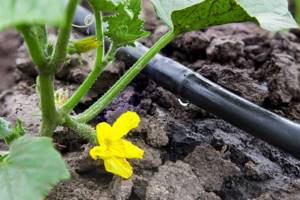
Drip irrigation is usually used to moisten the root zones of the plant.
The design of an automatic irrigation system is based on a previously developed scheme. At the first stage, a pipeline is laid with a slight downward slope for subsequent cleaning and draining of the system for the winter. Using fittings, parallel branches are made. The ends of the hoses must be closed with plugs.
Helpful advice! It is recommended to place hoses and pipes on the surface of the ground on special supports or pegs.
As a source of water supply for drip irrigation, a container of a certain volume is used, which is selected based on the number of green spaces. A filter is installed at the outlet of the tank, then a controller or timer. Next, the main pipeline is connected. After installation of the system is completed, it is tested. Then you should set the timer or controller to the required frequency and duration of watering.
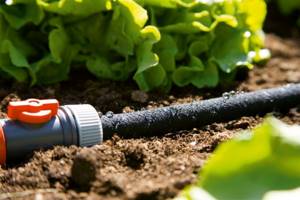
To distribute water, a main pipe is connected to the tank, from which there are branches to watering points
